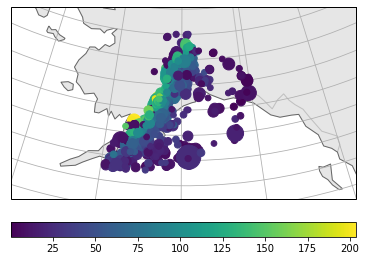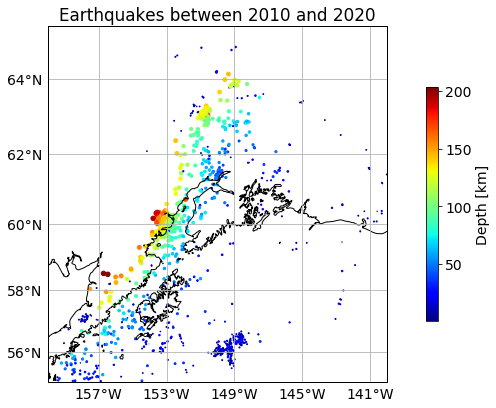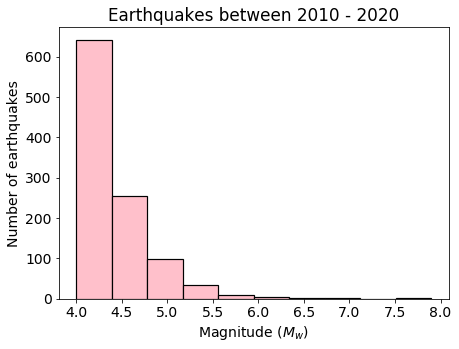Downloading earthquake data
Contents
Downloading earthquake data#
Seismology Independent Project - Geophysics There are many databases online we can download earthquake data from:
But what if we wanted to write our own code that downloads information on earthquakes? ObsPy library has exactly what we need to download data from IRIS!
Let’s start by loading all the necessary libraries:
from datetime import datetime
from dateutil.relativedelta import relativedelta
import matplotlib.pyplot as plt
import matplotlib.ticker as mticker
import cartopy.crs as ccrs
import cartopy.feature as cfeature
from cartopy.mpl.gridliner import LONGITUDE_FORMATTER, LATITUDE_FORMATTER
import pandas as pd
import numpy as np
Input parameters#
First we will specify a bunch of parameters that will be useful in choosing the earthquake data we are interested in.
Networks and stations#
We can specify particular seismograph networks and stations to be used when downloading the data. For example, we can look at IRIS online map that displays what networks and stations are within the region. If we want to specify either of them, we need to put a list of strings with short codes, such as ‘TA’ for Transportable Array network in USA and ‘O20K’ for a station in Alaska. In this exercise, we will want all the networks and stations, therefore we can assign ‘None’ to the variables:
network = None
station = None
Start and end time#
Usually we want to specify the time window for which we want the earthquake data downloaded. The code takes date and time in UTC format that we can use datetime library for. The required format is:
1970-01-01 01:01:1.01
In this example, we will specify end time to be current date and start time to be \(10\) years prior:
start_time = datetime.utcnow() - relativedelta(years=10)
end_time = datetime.utcnow()
print(start_time, end_time)
2010-06-28 14:56:09.116501 2020-06-28 14:56:09.116501
Boundaries#
We may specify where the earthquakes should come from. We can either input a box boundary or central latitude and longitude and radius. In this example, we will look at a box and we will specify minimum and maximum latitude and longitude:
min_latitude = 55
max_latitude = 65
min_longitude = -160
max_longitude = -140
Magnitude and depth#
We can also specify the minimum and maximum magnitude and depth of the earthquakes downloaded. In this example we will set a minimum magnitude, no maximum magnitude and no depth constraints.
min_mag = 4.0
max_mag = None
min_depth = None
max_depth = None
Accessing IRIS#
ObsPy has many classes and functions that interact with IRIS earthquake database. The Client class creates a wrapper around IRIS Web services and allows you to access information from Python.
from obspy.clients.fdsn import Client
client = Client("IRIS")
To access earthquake catalogue we can use:
client.get_events()
All keyword arguments are listed here.
catalogue = client.get_events(starttime=start_time,endtime=end_time,\
minlatitude=min_latitude,maxlatitude=max_latitude,\
minlongitude=min_longitude,maxlongitude=max_longitude,\
minmagnitude=min_mag, maxmagnitude=max_mag,\
mindepth=min_depth, maxdepth=max_depth)
print(catalogue)
1045 Event(s) in Catalog:
2020-06-18T20:38:43.258000Z | +60.887, -149.086 | 4.2 ml
2020-06-12T04:48:49.070000Z | +57.325, -155.204 | 4.4 mb
...
2010-07-11T07:07:23.870000Z | +56.743, -154.008 | 4.0 mb
2010-07-08T03:15:49.260000Z | +61.857, -150.527 | 4.7 MW
To see all events call 'print(CatalogObject.__str__(print_all=True))'
We can plot the catalogue using built-in ObsPy functions to quickly visualise the data:
catalogue.plot(projection="local", label=None, method="cartopy", title="")
plt.show()

The catalogue states that we have over \(1000\) events recorded by IRIS for given parameters. Now we will want to access the data in the catalogue.
If we loop over elements, or events in the Catalogue we can access different information. Below we will extract origin time of the earthquake, its location, depth and magnitude:
# Create empty lists
year = []
month = []
day = []
hour = []
minute = []
second = []
lat = []
lon = []
dep = []
mag = []
time = []
# Loop over each event in the catalogue
for event in catalogue:
year.append(event.origins[0].time.year)
month.append(event.origins[0].time.month)
day.append(event.origins[0].time.day)
hour.append(event.origins[0].time.hour)
minute.append(event.origins[0].time.minute)
second.append(event.origins[0].time.second)
lat.append(event.origins[0].latitude)
lon.append(event.origins[0].longitude)
dep.append(event.origins[0].depth/1000.)
mag.append(event.magnitudes[0].mag)
Custom data plotting#
For custom plotting, we can create a pandas DataFrame with all the information on earthquakes:
data = pd.DataFrame(np.array([year, month, day, hour, minute, second, lat, lon, dep, mag]).T,
columns=["year", "month", "day", "hour", "minute", "second",
"lat", "lon", "depth_m", "mag"])
data.head(3)
| year | month | day | hour | minute | second | lat | lon | depth_m | mag | |
|---|---|---|---|---|---|---|---|---|---|---|
| 0 | 2020.0 | 6.0 | 18.0 | 20.0 | 38.0 | 43.0 | 60.8872 | -149.0860 | 28.2 | 4.2 |
| 1 | 2020.0 | 6.0 | 12.0 | 4.0 | 48.0 | 49.0 | 57.3254 | -155.2038 | 49.1 | 4.4 |
| 2 | 2020.0 | 6.0 | 8.0 | 18.0 | 57.0 | 5.0 | 56.0446 | -153.7615 | 29.9 | 4.0 |
Code below will plot the downloaded earthquakes on a map:
plt.rcParams.update({'font.size': 14})
central_lon = min_longitude
central_lat = min_latitude
extent = [min_longitude,max_longitude,min_latitude,max_latitude]
fig, ax = plt.subplots(1, subplot_kw=dict(projection=ccrs.Mercator(central_lon, central_lat)), figsize=(7,7))
ax.set_extent(extent)
ax.coastlines(resolution='10m')
plt.title("Earthquakes between %g and %g" % (np.min(data.year), np.max(data.year)))
# Create a scatter plot
scatplot = ax.scatter(data.lon, data.lat, c=data.depth_m,
s=data.depth_m/10, cmap="jet",
transform=ccrs.Geodetic())
# Create colourbar
cbar = plt.colorbar(scatplot, ax=ax, fraction=0.03, pad=0.1, label='Depth [km]')
# Sort out gridlines and their density
xticks_extent = list(np.arange(min_longitude-5, max_longitude+5, 4))
yticks_extent = list(np.arange(min_latitude-3, max_latitude+3, 2))
gl = ax.gridlines(linewidths=0.1)
gl.xlabels_top = False
gl.xlabels_bottom = True
gl.ylabels_left = True
gl.ylabels_right = False
gl.xlocator = mticker.FixedLocator(xticks_extent)
gl.ylocator = mticker.FixedLocator(yticks_extent)
gl.xformatter = LONGITUDE_FORMATTER
gl.yformatter = LATITUDE_FORMATTER
plt.show()

Here we can plot a histogram of earthquake magnitudes:
plt.rcParams.update({'font.size': 14})
plt.figure(figsize=(7,5))
plt.title('Earthquakes between %g - %g' % (np.min(data.year),
np.max(data.year)))
n,bins,patches = plt.hist(data.mag, color='pink',edgecolor='black',
linewidth=1.2)
plt.xlabel('Magnitude ($M_w$)')
plt.ylabel('Number of earthquakes')
plt.show()



